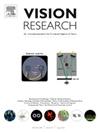特征协同增强检测,但不能从纹理线索识别形状
IF 1.4
4区 心理学
Q4 NEUROSCIENCES
引用次数: 0
摘要
在多个局部特征上与周围环境不同的纹理区域更容易被检测到。最近的研究结果表明,低水平的汇总统计,净对比能量,预测了这种双线索优势,表明在图像分析的早期阶段整合。我们调查了这一优势是否也适用于更复杂的,纹理定义的形状辨别超越图形-背景隔离。使用图形检测任务和更苛刻的形状识别任务,我们通过方向或空间频率对比定义的单线索目标校准d '对固定基线水平的灵敏度。然后,我们在这些基线上测量了双线索目标的性能。与先前报道的简单形状识别结果相反,我们发现在形状识别任务中减少了双线索优势。具体来说,双线索灵敏度明显低于单线索灵敏度的代数和,这在检测任务中是一致的。具有高特征对比的对照试验对单个线索和组合线索的检测效果都很好。然而,形状识别的准确度在83%-90%之间饱和,而灰色阴影的图形产生了完美的表现,这表明单一或组合纹理线索无法构建独特的形状表示。这些结果表明,纹理线索和增强了纹理分离和分割,但没有提高二维纹理形状的高级识别。本文章由计算机程序翻译,如有差异,请以英文原文为准。
Feature synergy enhances detection but not recognition of shape from texture cues
Texture regions that differ from their surroundings in more than one local feature are more easily detected. Recent findings show that a low-level summary statistic, net contrast energy, predicts this double-cue advantage, suggesting early-stage integration during image analysis. We investigated whether this advantage also applies to more complex, texture-defined shape discrimination beyond figure-ground segregation. Using both a figure detection task and a more demanding shape identification task, we calibrated sensitivity to fixed baseline levels with single-cue targets defined by orientation or spatial frequency contrast. We then measured performance for double-cue targets at these baselines. Contrary to earlier results reported for simpler shape discriminations, we found a reduced double-cue advantage in the shape identification task. Specifically, double-cue sensitivity was notably lower than the algebraic sum of the single-cue sensitivities, a level achieved consistently in the detection task. Control tests with high feature contrast showed perfect detection performance for both single and combined cues. However, shape identification saturated at levels between accuracy, while gray-shaded figures yielded perfect performance, suggesting that unique shape representations could not be built from single or combined texture cues. These findings suggest that texture cue summation enhances texture segregation and segmentation but does not improve higher-level recognition of 2D texture shapes.
求助全文
通过发布文献求助,成功后即可免费获取论文全文。
去求助
来源期刊

Vision Research
医学-神经科学
CiteScore
3.70
自引率
16.70%
发文量
111
审稿时长
66 days
期刊介绍:
Vision Research is a journal devoted to the functional aspects of human, vertebrate and invertebrate vision and publishes experimental and observational studies, reviews, and theoretical and computational analyses. Vision Research also publishes clinical studies relevant to normal visual function and basic research relevant to visual dysfunction or its clinical investigation. Functional aspects of vision is interpreted broadly, ranging from molecular and cellular function to perception and behavior. Detailed descriptions are encouraged but enough introductory background should be included for non-specialists. Theoretical and computational papers should give a sense of order to the facts or point to new verifiable observations. Papers dealing with questions in the history of vision science should stress the development of ideas in the field.
 求助内容:
求助内容: 应助结果提醒方式:
应助结果提醒方式:


